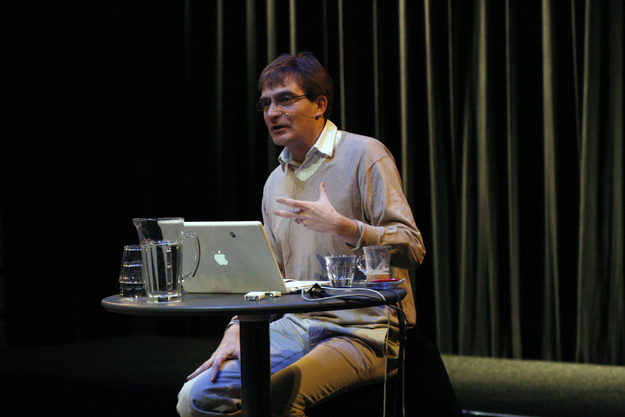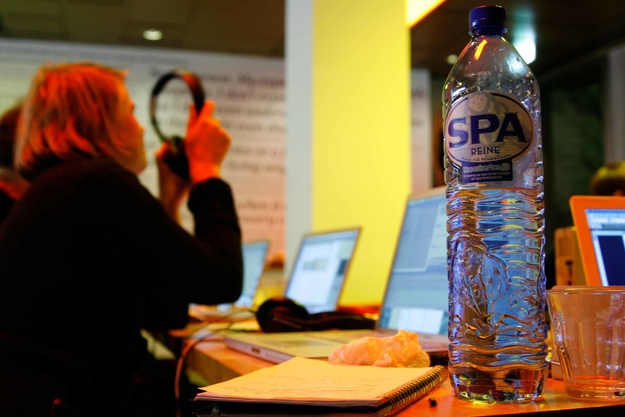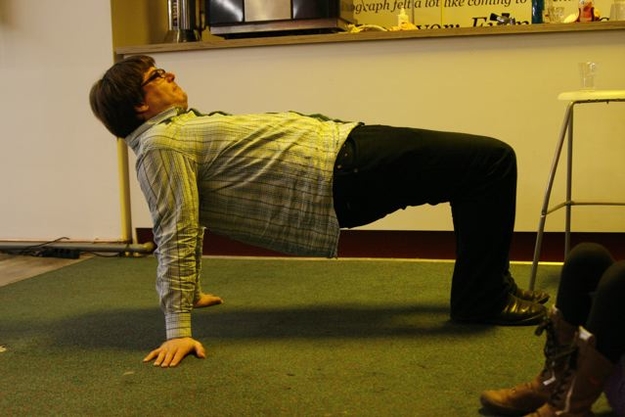After this Kick-Off the workshop participants moved through the rainy streets to Mediamatic at Vijzelgracht and were greeted with a tasty mediterranean style lunch. Then, back to business, workshop trainer Klaas Kuitenbrouwer introduced them to the seemingly infinite possibilities of new media tools..., the Korsakow-System for instance (a software to create non-linear narratives) but also more widely known internet platforms such as Flickr and YouTube. Another focus of this years Workshop is GPS-technique and how it can be converted into narratives or incorporated in art projects.
Afterwards the participants started discussing their own ideas which are quite diverse -
Joyce Treasure would like to make a film about the relationship between young people and their dogs. Since it has become fashionable among London teenagers to have staffordshire- or pitbull terriers. Her idea is to take a closer look at the „scene“ by establishing a fictional character alongside documentary footage of young dog owners.

Paul Thwaites has the ambitious goal to reinscribe his former harpsichord teacher Mary Potts into history. He plans on doing so by creating an archive of people whom she influenced, containing movie clips, photos and narratives.
Daniela Paes Leão's project is dealing with the relationship of a sponsor and a sponsored in an artistic context.
Having just returned from a half-year backpacking trip Lucie Boucek is thinking about a way to connect personal memories to certain places. She might do so by using an internet platform such as ning and combine that with an openstreetmap.
Holger Mohaupt is going to work on an art project about sharing a perspective and navigating trough an urban environment in a different way.
Eveline van Dijck and Marjolijn Ruyg are working on a documentary about Opensource and are starting an online network to stimulate its use. They are using Korsakow and ning as an online resource tool.
Saskia Korsten is going to make a project on stigmatized muslim youth in Amsterdam. Under the title „stare wars“ she works on the idea of how those teenagers use the video-mode of their cell-phones as a weapon to shield themselves from scornful gazes.
Romana Zajec is planning to make a documentary about climate refugees. It’s going to be a 4-part docu-series and during the workshop she will be focussing on the online part of the project.
Ana Fratnik is working on a documentary of the Slovenia Biennale that she plans to assemble in Korsakow.
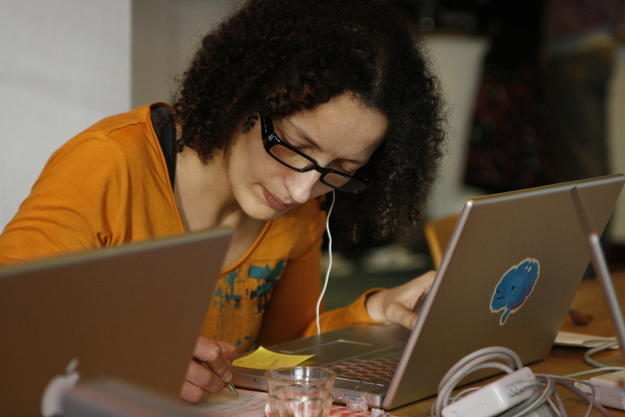
And last but not least Menno Grootveld is going to create a documentary about a pirate radio station he was involved with in the 80'ies.
Let's see how those ideas evolve during the course of the workshop...
Day 2
On Saturday morning Cassian Harrison was invited to the workshop-space again. He talked about some interesting TV- and Radioprograms he produced besides „Britain From Above.“ A very intimate documentary was one of a soldier's wife reading letters her husband wrote from Iraq before he was killed in action.
Afterwards Dutch artist Esther Polak gave a lecture about her work with GPS-data. In different projects she hooked people up with GPS-devices and pinned down their „maps of movement.“ What fascinates her is the experience of „realism“ described by people looking at their GPS-tracks and compares it to the feeling people must have had while looking at images of their own face in the early days of photography. Furthermore it’s the fact of "how economy determines public space" that interests her.
During the past years she worked with the recorded movements of milk-farmers in Latvia, cyclists in Amsterdam and tribes in Nigeria. A crucial part of her work is to expose the actors to the patterns of their movement in the end.
Esther Polak explaining the MILKproject -
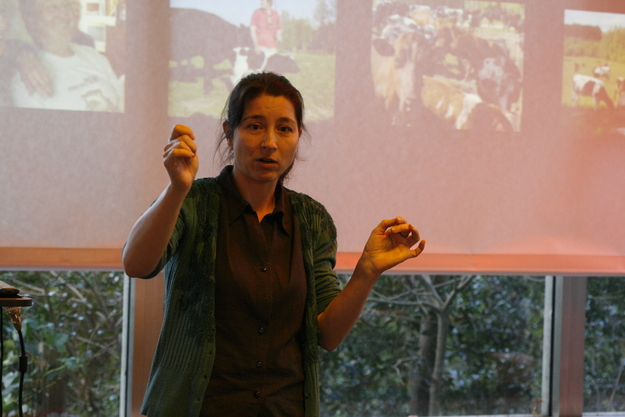
Then Florian Thalhofer, creator of the Korsakow-System, arrived by night train from Munich.
After lunch he and Jacob Schillinger explained the basic structures of the system. Half the participants had decided to use Korsakow for their art project, the other half focussed around the idea of mapping systems and the usage of GPS-technology. Those guys were supported by Esther Polak and Tijmen Schep.
Florian Thalhofer - hands-on Korsakow -

Day 3
Sunday Morning started with the lecture „Content, Context, Contact“ by Klaas Kuitenbrouwer. Creating a new media art piece you should contemplate the three C’s at an early stage...of course you’d think of what it is about but do you also consider in what context it will be shown? What’s the physical and spacial experience of it and how does that possibly affect the content? And in the end it’s the contact of the viewer with the piece that makes you aware of your own work and might give you a different approach to it.
The guest-lecturer on Sunday was Erik Borra – new media developer and web researcher at the University of Amsterdam. He displayed in an inspiring way how politics and trends in society evolve trough the internet. To point out the web’s mechanics he used US-elections 2008 as an example – they had like no other before been determined by the use of new media. With a group of researchers associated around issuecrawler.net and digitalmethods.net Erik Borra developed a variety of tools to analyse search engines and examine what parameters affect web queries. The results are quite astonishing – and seem to make the internet an anticipatory medium. Like it had been „foreseen“ by Wikipedia-observers that Joe Biden would be appointed as candidate for Vice-President (the changes on his Wikipedia-article had been taken as an indicator). Erik Borra emphasized that the internet can not be taken as „one medium.“ According to him it consists of a variety of media, each of which follows its own mechanisms – it’s on you to pick the right one for your purposes...

In the Afternoon Florian Thalhofer did some more hands-on Korsakow...while outside the snow started falling in big flakes...amazing how cozy a computer-workshop can be...
Day 4
Monday is a busy day. No lectures, just hardworking participants. (Even though some of them seem to be slightly hungover...) Yet we are getting closer to the end – and the final presentation tomorrow night...so how far have we got?
Some of the concepts are still very close to the initial idea, others have changed a great deal.
Like in Saskia Korsten’s project for instance – it started out with the idea of having the muslim teenagers film the people staring at them. After some test-shooting she realized that the immediate reaction of people being filmed by mobile phones is to laugh. That made her think that for a project like hers it would be important to preserve a game character. Now the idea is to make a map of the „territory“ and let the youngsters challenge adult yuppies to a „stare out.“ Who laughs first looses territory. That will be marked on the map displayed in local shops. An additional part of the project will be to analyse the media perception of „muslim youth“ together with the ones discussed.
For Romana the idea is still close to what it was in the beginning – she’s developing a website to go along with a TV-documentary about climate refugees. On the site she will use different forms of mapping coordination so the user can zoom into individual stories coming visually from a global perspective.
Ana is working on the documentary of the Slovenia Biennale which will be assembled in Korsakow.
Holger is still in the process of finding the right concept. His idea is to make a connection between locative data and real locations. There are photos of a China-trip that he tries to transfere to this culture by linking them to products „made in China“ you can find in Europe. For now he will find those connecting points in Amsterdam and set GPS-marks at locations with an abundance of Chinese products. That will be visually related to the images of China he collected. „Tangible Diffusions“ is the working title of his project.
Daniela has gotten further into her project about an artist and the artist’s founder swapping their position that she documented for six months. She assembled the material – video footage and e-mail correspondences between the two – in Korsakow and is about to figure out how clear the initial situation has to become for the viewer.
Radically changed has the concept of Lucie. Respectively she decided to do a whole different project. It’s not about a backpacker’s social network anymore but about promoting her own website. Using Flickr, Google Maps, ning and the video-annotation-mode in YouTube she wants to test out what these viral marketing strategies can do.
Day 5
The last day starts out with a lecture by Alexandre Brachet. He pitched his online-documentary GazaSderot (an Arte-collaboration that deals with everyday-life in Israel and Palestine) at IDFA. Mediamatic invited him to talk about other innovative internet-projects he produced during the past years with his company „Upian.“ In some there prevails a form of „investigative journalism“ like in the interactive reportage on a city in Mexico where hundreds of women were killed for no evident reason, others work in a more poetic way with narratives. In his opinon it is also important to do some commercial projects – not only for the money but to get ideas about how the internet works and what changes are going on. He shared his ideas about marketing quite openly and admitted that there is a „jekyll and hide-side“ to his business. But nevertheless he uses the internet as a medium in an inspiring political way.
So the rest of the day was dedicated to finish up concepts and projects – in the afternoon they were presented to the workshop group.
For some of the participants the goal had mainly been to learn about new technology and software in a creative environment...Holger Mohaupt for example intends to use locative media in future-projects and the workshop was a great opportunity for him to see what can be done with GPS and GoogleMaps. For now he attached some China-photos in a virtual map of Amsterdam at locations that visually correlated to those images.
Marjolijn and Eveline assembled quite an astonishing collage of opensource material in Korsakow – interviews and videoclips they had found on the internet next to excerpts of the documentary they are making on the topic. Marjolijn had been really interested in learning about the Korsakow-system which they might now use to create the online part of the documentary.
Saskia talked about what concepts she had developed troughout the workshop. In January she will start the „muslim-youth“ project in Amsterdam previously described.
Lucie presented how the website moodya.com could be promoted more effectively. The interactive gimmik for teenage girls that she created invites the user to upload a portrait and after analysing its mood provides a matching ringtone. By using video-annotations on YouTube, connecting the link to certain Flickr-groups and embedding it into GoogleMaps she was humorously playing around with the idea of how to get more traffic on the site.

Florian REALLY needs to stretch a little...
Ana showed an interesting Korsakow-medley of the Ljubljana Graphic Arts Biennial in that she had structured the material shot on location.
Romana designed some innovative layouts for the website that will go along with her documentary on climate refugees. She also tagged some research results to locations in GoogleMaps so people will stumble upon the information about endangered areas and the immigration movements caused by it.
Paul Thwaites started to assemble the Mary-Potts-archive in Korsakow – a mix of old photos, films and interviews gave the idea of what a person his former harpsichord teacher must have been. As he says it’s still a long way to go though before accomplishing this big-scale project. At the end of his presentation he stated „if I would wear a hat I would take it off at this point.“ He didn’t specify to whom though...
Daniela showed a very contemplative work about sponsor and sponsored swapping their office locations (set up in Korsakow.) In an intriguing way the multiple layers of reflection and thought are visually transposed.
The work-in-progress Joyce Treasure presented was quite amusing. Her story about a Jamaican girl who owns a Staffordshire-Terrier was combined with the thoughts of different dogs and facts on adequate animal housing.
Afterwards pizza was ordered, beer was handed out and chairs were moved around to make room for the official final presentation. Soon the outside-guests arrived and Klaas Kuitenbrower gave a talk on the workshop process and its results. It merged into an interesting discussion about new ways of locative art and interactive narration – in many ways referring to the talks given troughout the workshop. Then we went for another beer...
